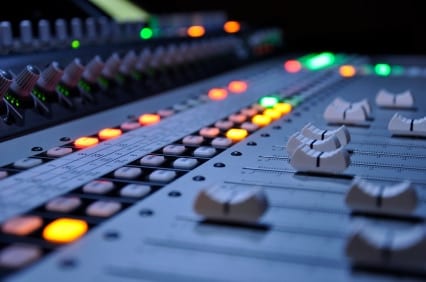Home Recording Academy: Glossary of Home Studio Terms A-M
Each week, the Sage Audio Mastering Blog presents another installment of the Home Recording Academy, a series of articles designed to provide helpful tips to everyone that is recording at home now, or hopes to in the future.

The first installments of the series have focused on the basics of recording knowledge and technology, and we thought it would be helpful to include a glossary of home studio terms you will see in coming articles. Some of these are technical terms like dynamic range and overdubbing, while others are those less definable terms you’ll hear thrown around all studios like bright, fat or warm.
Here’s terms starting with A-M, and we’ll be back next week with the rest.
A/D Converter: Stands for analog to digital converter. In recording studios this is any circuit that takes an analog sound signal and converts it into a digital signal.
Airy: The first of those “less definable” terms. Airy means a spacious sound, an instrument or vocal that seems to be surrounded by a reflective space full of air.
Analog: any signal that has not been digitized by any means.
Audio Spectrum: The range of sound that can be heard by the human ear. The spectrum of frequencies is generally between 20 and 20,000 Hz.
Bandwidth: This is the range of frequencies produced by an instrument or amplifier.
Bright: This sound pops out of a mix because of emphasized high frequencies, it is not muffled or buried.
Buried: Often this means turning down volumes or certain frequencies so that unwanted sounds are not prominent in a mix. *Side note example: The Traveling Wilburys took their name after noticing some recording mistakes. George Harrison told Jeff Lynne that “We’ll bury ‘em in the mix.”
Bus: This is a signal path that sends signals to certain destinations. For example, certain audio signals may be sent from a console to an effects rack.
Clean: A signal that has no distortion or unwanted noise.
Compressor: A piece of equipment that reduces the dynamic range on an audio track. See more here in our “What is Compression” article.
Condenser Microphone: A microphone best suited for mic-ing low volume sounds like vocals and acoustic instruments, as well as audio sources not immediately in front of the mic. There are two types of condenser mics: large diaphragm and small diaphragm. Read more about home studio microphones here.
Decibel (dB): Human ears respond logarithmically to sounds, so a decibel measures effective sound pressure against a reference value, in this case 0 dB. As an example of how this works, turning a signal down by 3 dB reduces the signal power by half.
Digital Audio Workstation (DAW): A system to record audio digitally, often involving both hardware and software elements. Check out our guide to the best DAW for your home studio.
Dry: A signal with no effects (reverb, delay, etc.) Sounds exactly as it did when recorded.
Dynamic Microphone: Great for loud sounds that are close to the microphone, and does not require phantom power like most condenser mics. See more here.
Dynamic Range: The difference between the softest volume on a track and the loudest, measured in dB.
EQ (Equalization): the system that allows you to raise or lower certain frequencies across the audio spectrum. Learn more in our What is EQ guide.
Fat: Also known as full or warm, a track that sounds as if the signal is spread across a wide spectrum. The opposite of thin.
Headphones: Pretty self-explanatory as to what they are, but many kinds are available. For example, noise canceling headphones can be useful in a home studio if you record in the same room you perform in. Headphones can range from very inexpensive to thousands of dollars per pair. A note, headphones should not be used as an alternative to studio monitors.
Limiter: A device that sets a threshold volume at a certain dB level and lowers the volume of any signal that goes above that level.
Low-Fi: Stands for low fidelity, or poor recording quality. This sound is sometimes replicated in Hi-Fi (High Fidelity) studios for effect.
Mastering: One of the most crucial (but often misunderstood) elements of finishing your recorded product. Learn more at out online mastering services page – after all, this is what we do.
MIDI: Short for Musical Instrument Digital Interface. It is used to control a signal rather than create a signal.
Mix Down: a final mix of all your individual audio tracks, with the proper volumes and effects on each.
Muddy: A sound that is not clear, often the result of emphasis in the 200-350 HZ range, audio leakage and/or too much low-end reverb.




